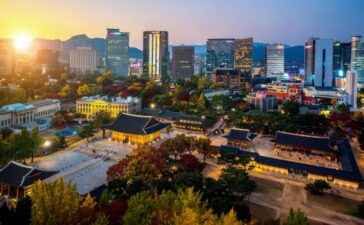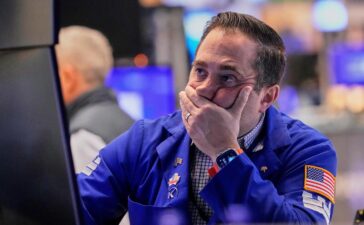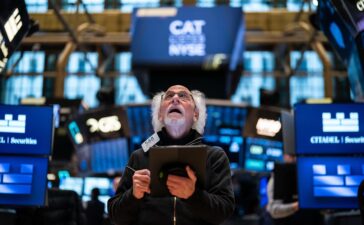The ripple effects of the U.S. Federal Reserve’s 11-month hold on interest rates is already being felt in Asia.
The debate over the domestic impact of what is shaping up as a delayed and shallow Fed easing cycle is far from settled. But the allure of U.S. interest rates staying in a range of 2% to 4% for several years is drawing money from the rest of the world into the U.S., with the country now accounting for one-third of global capital flows according to International Monetary Fund figures.
Asia is no exception. The Bloomberg Asia Dollar Index, a basket of Asian currencies with high liquidity and large trade flows with the U.S., has weakened 13% over the last three years as capital outflows undercut the region’s currencies.
Yet the risks of this outpouring of capital getting out of control do not appear large.
Asia’s fundamentals are quite different than they were at the time of previous big selloffs, like the 2013 “taper tantrum” which battered the Indian rupee and Indonesian rupiah or the 1997 Asian financial crisis.
Asian economies are much more resilient, foreign exchange reserves are larger and there is stronger regulatory oversight of foreign currency debt. These factors have contributed to a controlled depreciation of most Asian currencies this time, with minimal impacts so far on the broader economy.
Additionally, monetary policy in Asia is now more attuned to external and financial risks. While local fundamentals were the primary driver of rate hike decisions in 2022 and 2023, these days the Fed is in focus as Asian central banks contemplate whether to begin cutting rates. Even the Bank of Thailand has been hesitating to preempt the Fed in trimming rates despite experiencing deflation for much of the year to date.
The attention to the Fed is partly a function of the market’s growing preference for the dollar as the “higher for longer” theme gains traction.
Despite Asian economies’ robust external balances, going against strong market forces can lead to significant currency pain. While it would be possible to temporarily decouple from the Fed, signaling alignment with it over the long term, in the way the European Central Bank has, could help minimize capital outflow and currency risks.
Admittedly, conditions in Asia may make this approach tricky.
While inflation has entered a sticky patch in many Asian economies and uncertain food inflation clouds the near-term outlook, the region’s long-term inflation challenge is likely smaller than that of the U.S.
There are good reasons to believe that the U.S. has entered a period of structurally higher inflation. With globalization on its backfoot and new tariff and import barriers rising, a green transition underway and an aging population, U.S. inflation is likely to average 2% to 3% over the next several years, up from a long-term pre-pandemic average of 1.8%.
Many of the factors affecting the U.S. apply to Asia as well, particularly its developed economies. But their impact will likely be dented by the disinflationary force of Chinese imports.
China’s rising manufacturing surplus means that its exports are likely to stay cheap for several years. This will probably not impact Western economies so much due to tariffs and other import restrictions.
Asia, though, is another matter and the disinflationary impact of Chinese imports is likely to be significant, particularly in the manufacturing sector, given the region’s high reliance on China for intermediate inputs.
This would suggest the region’s economies should be looking at deeper rate cuts than the U.S. This is especially the case for Southeast Asia and India. In both areas, the case for policy support for growth is strong, given that gross domestic product growth has slipped substantially below pre-pandemic trend lines.
A dramatic shift in policy considerations seems unlikely. In an environment of broad dollar strength, central banks will be cautious in adding to currency depreciation pressures that could end up amplifying macrofinancial risks. Most seem likely to cumulatively cut rates by no more than half a percentage point through next March.
If the gap in real policy rates between Asia and the U.S., factoring in inflation, does widen, this will make Asian assets more attractive on margin. This should allay concerns of capital flight, assuming the market looks beyond the difference in headline interest rates.
Other factors are also likely to come to the fore as the transition to higher-for-longer rates proceeds. After all, the price of capital is not the sole arbiter of capital allocation decisions. Interest rate differentials matter a lot for leveraged investors like hedge funds. But returns for institutional investors, who have longer-term horizons, are contingent on a host of factors, including growth prospects, inflation and exchange rate regimes, institutional quality, policy frameworks, sovereign ratings and political risk.
For such investors, Asia should remain a compelling choice, with a number of major markets featuring investment-grade ratings, a relatively favorable inflation environment, proven resilience to external shocks, stable political outlooks, credible policy frameworks and promising supply chain prospects.
Although major institutional investors have recently been increasing their portfolio allocations for Asian markets, such exposure typically represents only 7% to 8% of assets under management. So there is considerable scope for more funds to be sent to the region. A similar dynamic could be in the works with foreign direct investment as well.
Ultimately, sustained inflows of long-term capital would help drive a self-reinforcing cycle of growth, investment and external resilience in Asia. This would not only be positive for the region’s long-term economic prospects, but also further enhance its ability to weather the financial stresses that may periodically arise as the world adjusts to the new rate environment.
By Priyanka Kishore, founder and principal economist at Asia Decoded in Singapore.
















